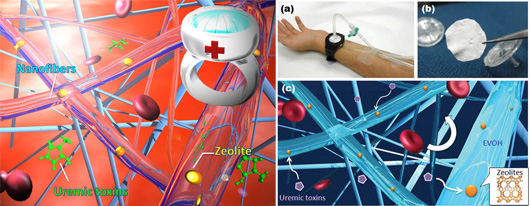- ホーム
- > 研究活動
- > Research Highlights
- > Vol. 11 A simple way to treat kidney f・・・
 Research Highlights
Research Highlights
[Vol. 11]
A simple way to treat kidney failure
A new technique for purifying blood using a nanofiber mesh could prove useful as a cheap, wearable alternative to kidney dialysis.

Figure : The newly-fabricated nanofiber mesh for the removal of toxins from the blood, made by WPI-MANA researchers, may be incorporated into wearable blood purification systems for kidney failure patients.
Kidney failure results in a build up of toxins and excess waste in the body. Dialysis is the most common treatment, performed daily either at home or in hospital. However, dialysis machines require electricity and careful maintenance, and are therefore more readily available in developed countries than poorer nations. Around one million people die each year worldwide from potentially preventable end-stage renal disease.
In addition to this, in the aftermath of disasters such as the Japanese earthquake and tsunami of 2011, dialysis patients are frequently left without treatment until normal hospital services are resumed. With this in mind, Mitsuhiro Ebara and co-workers at the International Center for Materials Nanoarchitectonics, National Institute for Materials Science in Ibaraki, Japan, have developed a way of removing toxins and waste from blood using a cheap, easy-to-produce nanofiber mesh1. The mesh could be incorporated into a blood purification product small enough to be worn on a patient's arm, reducing the need for expensive, time-consuming dialysis.
The team made their nanofiber mesh using two components: a blood-compatible primary matrix polymer made from polyethylene-co-vinyl alchohol, or EVOH, and several different forms of zeolites - naturally occurring aluminosilicates. Zeolites have microporous structures capable of adsorbing toxins such as creatinine from blood.
The team made their nanofiber mesh using two components: a blood-compatible primary matrix polymer made from polyethylene-co-vinyl alchohol, or EVOH, and several different forms of zeolites - naturally occurring aluminosilicates. Zeolites have microporous structures capable of adsorbing toxins such as creatinine from blood.
Although the new design is still in its early stages and not yet ready for production, Ebara and his team are confident that a product based on their nanofiber mesh will soon be a feasible, compact and cheap alternative to dialysis for kidney failure patients across the world.
Reference
"Fabrication of zeolite-polymer composite nanofibers for removal of uremic toxins from kidney failure patients"
Koki Namekawa, Makoto Tokoro Schreiber, Takao Aoyagia, and Mitsuhiro Ebara
Journal : Biomaterials Science 2, 674-679, (2014)
DOI : 10.1039/c3bm60263j
Koki Namekawa, Makoto Tokoro Schreiber, Takao Aoyagia, and Mitsuhiro Ebara
Journal : Biomaterials Science 2, 674-679, (2014)
DOI : 10.1039/c3bm60263j
Affiliations
International Center for Materials Nanoarchitectonics (WPI-MANA), National Institute for Materials Science (NIMS), Namiki 1-1, Tsukuba, Ibaraki 305-0044, Japan
Contact information
ナノアーキテクトニクス材料研究センター(MANA)
〒305-0044 茨城県つくば市並木1-1
TEL: 029-860-4710
E-mail: mana-pr=ml.nims.go.jp([ = ] → [ @ ] )
TEL: 029-860-4710
E-mail: mana-pr=ml.nims.go.jp([ = ] → [ @ ] )

